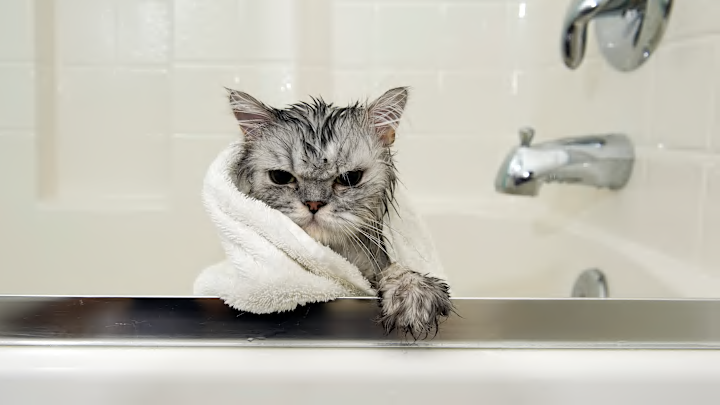Cats are meticulous about their hygiene, spending between 30–50 percent of their waking hours grooming. And while they are very capable of staying clean from head to tail on their own, there are a few situations where giving your cat a bath is necessary—though it typically isn’t a fun experience for either kitty or owner.
“I’ve only seen a couple of cats who like the bath, and that’s probably because they were introduced to it as kittens and it was a positive experience,” Tori Schlosser, certified cat trainer and owner of Purrsuasion Cat Training in Regina, Saskatchewan, tells Mental Floss. “Most cats don’t love it. If I tried to put my own cat in the bath, I would come out shredded.”
You may need to give your cat a bath if your veterinarian has recommended it for a skin condition like ringworm or a flea treatment, or if their fur is covered in a substance that’s impossible or dangerous for them to lick off. Hairless cat breeds like the Sphynx actually require regular baths to keep dirt and grime off of their skin.
Sometimes, only one part of your cat will need some extra cleaning. There are bath alternatives for these circumstances—Schlosser suggests using a cat-safe wipe or waterless shampoos to clean the specific areas you need to target.
Schlosser recommends taking your cat to the vet if you notice sudden cat coat changes, as it may be related to an allergy or other health problem. “If your cat’s butt is always dirty, that may be because they are overweight, or your senior cat may be arthritic, and they are not able to reach the area anymore,” she says. Changes to the overall texture and shine of your cat’s fur may be related to feline health conditions including hyperthyroidism, digestive problems, parasites, and allergic skin diseases.
What You Need to Give a Cat a Bath
If you have no other option but to give your cat a full bath, it’s important to be prepared before you start scrubbing. Make sure you have the right supplies:
- A non-slip mat for whatever basin, sink, or tub you plan to wash them in
- Washcloths
- A cup or pitcher for scooping water
- A big towel
- Cat-safe shampoo (Schlosser advises to never use human shampoo on a cat, and to stick with hypoallergenic “cat-safe” shampoos, not just “pet-safe” ones)
- Treats, and someone to dole them out during the bath
Step-by-Step Instructions on How to Bathe a Cat
Cats, by nature, don’t typically like water. You’ll have the best chances for success if you get the job done by taking it one step at a time. Here’s what to do:
- Add approximately 4 inches of warm—not hot—water to a tub or basin.
- Lower your cat into the water with their back toward you. Be gentle, and avoid grabbing a mature kitty by the back of the neck (a technique called “scruffing”). “Don’t scruff an adult cat, ever. If they are struggling that much, you might want to look at other options,” Schlosser says.
- Scoop some water over your cat’s coat; this is easier to do if someone else holds the cat for you.
- Apply and lather shampoo, taking care to avoid your cat’s face, especially the eyes and ears (you can wipe the tops of the ears and face with a warm cloth later).
- Rinse your cat thoroughly—any soap left on their coat can cause irritation.
- Wrap your cat up in a towel and dry them off as best you can. Be aware that they will probably go into self-grooming mode immediately after the bath.
- Praise your cat and give them some extra love—that was likely a stressful experience for them!
If your cat is aggressively fighting the bath, it’s best to try something less invasive. “You could fill a basin with warm water and dip a cloth in and wipe the cat down, without putting your cat directly into the water. Just have a really wet cloth and soak them,” Schlosser says.
Don’t be afraid to seek outside help if trying to bathe your cat turns into a stressful or dangerous situation. If everything you try is making both you and your kitty miserable, Schlosser recommends contacting a professional pet groomer.
Read More About Cats:
